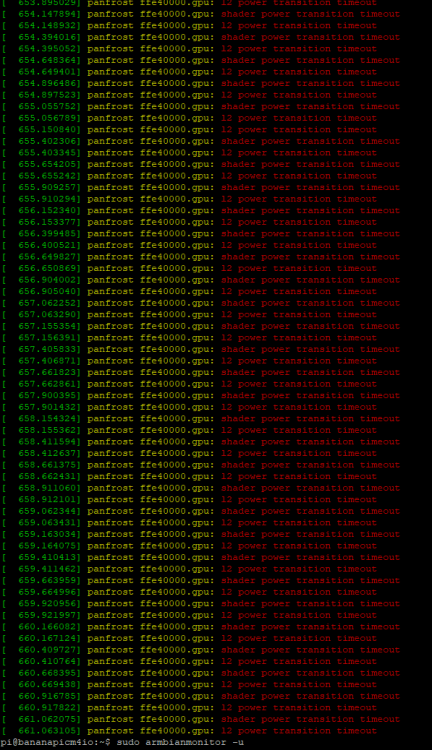Search the Community
Showing results for tags 'bananapicm4io'.
-
I have a Banana Pi CM4 + CM4 IO Board - literally the same one pictured in https://www.armbian.com/bananapicm4io/ I downloaded and installed Ubuntu 24.04 (Noble) Server Image - "Armbian_24.8.1_Bananapicm4io_noble_current_6.6.47.img" For convenience, I installed the image to an SD card. Armbianmonitor link: https://paste.armbian.com/igahozatow Everything boots and I can use armbian-config to connect to my local WiFi network, but the speeds are really really slow: iperf3 gives me ~40mbps pretty consistently: -------------------- [ ID] Interval Transfer Bitrate Retr [ 5] 0.00-10.00 sec 51.1 MBytes 42.9 Mbits/sec 2 sender [ 5] 0.00-10.20 sec 50.1 MBytes 41.2 Mbits/sec receiver I'm connected to a 5GHz network, good connection strength/quality (and I do have antennas plugged into the CM4) -------------------- wlan0 IEEE 802.11 ESSID:"unimportant" Mode:Managed Frequency:5.22 GHz Access Point: 70:A7:41:69:BA:14 Bit Rate=650 Mb/s Tx-Power=20 dBm Retry short limit:7 RTS thr:off Fragment thr:off Encryption key:off Power Management:off Link Quality=68/70 Signal level=-42 dBm Rx invalid nwid:0 Rx invalid crypt:0 Rx invalid frag:0 Tx excessive retries:0 Invalid misc:2 Missed beacon:0 Other devices on my network consistently push 300-400mbps iperf3. Also if I install and configure a mini-PCIe network card on the CM4IO board, that also gives me 300-400Mbps. I suspect the SDIO connection itself might be the bottleneck, though I'm new at this and might be barking up the wrong (device) tree here. The RTL8822CS module is connected to mmc2 per dmesg output: ----------------------- [ 7.539802] rtw_8822cs mmc2:0001:1: WOW Firmware version 9.9.4, H2C version 15 It appears mmc2 is running at only 25MHz 4-bit mode: cat /sys/kernel/debug/mmc2/ios ----------------------- clock: 25000000 Hz actual clock: 25000000 Hz vdd: 21 (3.3 ~ 3.4 V) bus mode: 2 (push-pull) chip select: 0 (don't care) power mode: 2 (on) bus width: 2 (4 bits) timing spec: 0 (legacy) signal voltage: 0 (3.30 V) driver type: 0 (driver type B) Of note - I came across this review/comparison (https://bret.dk/banana-pi-cm4-review/) of the BPi CM4 using the same CM4IO board as I'm using, except those iperf3 results make even less sense - 81 Mbps down / 158 Mbps up "bare", 12 Mbps down / 58 Mbps up using antennas. The author suspects that performance is better with "onboard PCB antennas", except I....don't see anything that looks like it would be an onboard PCB antenna - either on the module itself or in the schematic (https://drive.google.com/file/d/1IXXok1P2OLiW3p8tavkbfEPTGTrM3b-R/view?usp=sharing) They were using an older kernel / image (unclear where they got it from) so I wasn't able to replicate their findings, but perhaps there was some regression in the mmc controller setup? I'm not sure if this will help or not, but here are relevant excerpts from device tree on my image for the three mmc controllers: dtc -I fs /sys/firmware/devicetree/base ------------------------------- mmc@ffe05000 { pinctrl-names = "default\0clk-gate"; pinctrl-0 = <0x30>; clock-names = "core\0clkin0\0clkin1"; cap-sd-highspeed; vqmmc-supply = <0x32>; bus-width = <0x04>; resets = <0x05 0x2d>; interrupts = <0x00 0xbe 0x04>; clocks = <0x02 0x22 0x02 0x3d 0x02 0x02>; vmmc-supply = <0x2f>; compatible = "amlogic,meson-axg-mmc"; pinctrl-1 = <0x31>; status = "okay"; disable-wp; reg = <0x00 0xffe05000 0x00 0x800>; phandle = <0x130>; max-frequency = <0x2faf080>; cd-gpios = <0x07 0x2f 0x01>; }; mmc@ffe07000 { pinctrl-names = "default\0clk-gate"; pinctrl-0 = <0x33 0x34 0x35>; clock-names = "core\0clkin0\0clkin1"; vqmmc-supply = <0x1f>; mmc-hs200-1_8v; bus-width = <0x08>; resets = <0x05 0x2e>; interrupts = <0x00 0xbf 0x04>; clocks = <0x02 0x23 0x02 0x3e 0x02 0x02>; vmmc-supply = <0x2f>; mmc-ddr-1_8v; compatible = "amlogic,meson-axg-mmc"; pinctrl-1 = <0x36>; status = "okay"; disable-wp; mmc-pwrseq = <0x37>; reg = <0x00 0xffe07000 0x00 0x800>; phandle = <0x131>; max-frequency = <0xbebc200>; cap-mmc-highspeed; }; mmc@ffe03000 { pinctrl-names = "default\0clk-gate"; #address-cells = <0x01>; amlogic,dram-access-quirk; pinctrl-0 = <0x2c>; clock-names = "core\0clkin0\0clkin1"; vqmmc-supply = <0x2f>; bus-width = <0x04>; non-removable; resets = <0x05 0x2c>; interrupts = <0x00 0xbd 0x04>; clocks = <0x02 0x21 0x02 0x3c 0x02 0x02>; #size-cells = <0x00>; vmmc-supply = <0x2f>; keep-power-in-suspend; compatible = "amlogic,meson-axg-mmc"; pinctrl-1 = <0x2d>; status = "okay"; disable-wp; mmc-pwrseq = <0x2e>; reg = <0x00 0xffe03000 0x00 0x800>; phandle = <0x12e>; sd-uhs-sdr104; max-frequency = <0x2faf080>; wifi@1 { reg = <0x01>; phandle = <0x12f>; }; }; The RTL8822CS module itself should support SDIO 1.1 / 2.0 / 3.0 up to clock frequency of 208MHz, but it seems like for some reason the controller just isn't running at that speed and I'm not sure what exactly to change to fix that - anyone have any suggestions on what I'm doing wrong or what I should check next to debug this?
-
I am trying to set up a Banana Pi CM4 on a Bigtree Tech Manta M8P, which is a 3D printer board which has a socket for the CM4. However, I don't have the option to use a wired connection to the router or plug in a keyboard to interact with the CM4 on initial startup, so I get stuck at the set root password stage. Is there a way around this? I have tried using WSL to mount the SD card after burning, but I can't seem to access it there to change the files on the card directly. Ideally, I would like to burn Armbian with Wifi credentials already set so I can ssh from the start. I appreciate any help. Keep in mind that my Linux fu is about good enough to get Klipper going and maintained but little else, so type slowly so I can understand.
-
Hi, is posible to add Canbus by a MCP2515 in a spi port ? thanks!
-
Hello all, I noticed that since recently (TM) I got loads of spam from panfrost in my dmesg output: I understand that this has something todo with graphics. The only "graphic" thing I'm doing is running standard Klipper-Screen through HDMI and this seems to be working as always... It definately wasn't there like half a year ago. can I get rid of it? Is it something to worry about? my armbian is running on a Banana-Pi CM4 module of of the eMMC. It's a rather standard installation with Klipper installed via KIAUH. sincerely - cad435
-
unable to access gpio using wiringpi python. I have tried steps available on banana pi wiki. but it throws error "/dev/gpiomem" is not available and then "This board is not odroid". did anyone successfully implemented this?
-
Hi, I am using Armbian (latest) image on Banana Pi CM4 and I don't have access to gpio493. I am getting the following error: And looks like gpiochip4xx is not available: When I modprobe this gpio number, I am getting following error: modprobe: FATAL: Module gpiochip493 not found in directory /lib/modules/6.7.2-edge-meson64 Could you please help, how can I enable gpio 493? Thanks
-
I have just installed an Armbian Jammy CLI on my BPI-CM4. I need to use the UART that is routed to pins 8 and 10 on the 40-pin connector (UART_EE_B in the BPI-CM4 schematics). I have enabled it in the device tree by changing this from disabled to okay: serial@23000 { compatible = "amlogic,meson-g12a-uart\0amlogic,meson-gx-uart"; reg = <0x00 0x23000 0x00 0x18>; interrupts = <0x00 0x4b 0x01>; clocks = <0x12 0x02 0x2a 0x12>; clock-names = "xtal\0pclk\0baud"; status = "okay"; phandle = <0x12b>; }; Once rebooted, and new UART appears (ttyAML6). However, it does not work. What am I missing? Thanks in advance
-
Hello everyone, I am trying to get a Bigtreetech PiTFT70 DSI screen working on my Banana Pi CM4 mounted on a Bigtreetech Manta M8P 3D printer control board. It is supposedly a clone of the Raspberry Pi 7inch DSI display and uses the same display and touch chips. The DSI port on the M8P is wired to DSI 1 port on the Bpi CM4. I have tried hacking together a device tree overlay for it but I don't know enough of what needs turning on and what addresses they require (i2c etc) to get it working. Can anyone with Amlogic meson knowledge assist me? I am running the latest armbian bookworm 23.8 with all current updates installed.
-
I tried three way for hiding mouse, but not work: 1. Unclutter: ``` unclutter -idle 0 -root -display :0 `` It shows unclutter: could not open display 2. startx -nocursor -> not work 3. Using xbanish and boot from Systemd: ``` ~/.config/systemd/user/xbanish.service ``` [Unit] Description=xbanish After=default.target [Service] Type=simple ExecStart=/usr/bin/xbanish Restart=on-failure StartLimitBurst=10 RestartSec=30 [Install] WantedBy=default.target Is there any good way for hiding mouse on XFCE4 desktop (Armbian) ? Thanks
-
Is there, or will there be, an Amlogic or Banana Pi issued GPU blob to run Vulkan? On v6 kernel ideally Amlogic does have a history of allowing this, for Odroid and Khadas. Duncan
-
I have a 480*480 HDMI display. Using Armbian image cannot work, but Bananapi Official image support this resolution. I also tried to adjsut /boot/boot.cmd (Using 480p60hz) and add disp_mode=480x480 into ArmbianEnv.txt. Does anyone have any suggestions for a solution?
-
Hello, I tried ` echo 463 > /sys/class/gpio/export ` and it build gpio464 folder under /sys/class/gpio , and I cat `value` file to check gpio status. It seems not work. The same gpio was working on Bananapi official debian and Ubuntu mate image. How can I solve this problem? Thanks
-
hello, I found default armbian image will cause the CPU temperature very high. My cpu freq is setting 1Ghz and usage is around 20%, This should not cause the cpu to overheat. This is my armbianmonitor -m : ``` Time CPU_cl0/CPU_cl1 load %cpu %sys %usr %nice %io %irq Tcpu C.St. 18:55:22 1000/1000 MHz 0.88 17% 6% 9% 0% 0% 1% 103.0 °C 8/8 18:55:27 1000/1000 MHz 0.89 17% 5% 9% 0% 0% 1% 103.0 °C 8/8 18:55:32 1000/1000 MHz 0.90 17% 5% 9% 0% 0% 1% 103.1 °C 8/8 18:55:37 1000/1000 MHz 0.83 17% 5% 9% 0% 0% 1% 103.2 °C 8/8 18:55:42 1000/1000 MHz 0.76 17% 6% 9% 0% 0% 1% 103.1 °C 8/8 18:55:47 1000/1000 MHz 0.86 17% 5% 9% 0% 0% 1% 103.2 °C 8/8 18:55:52 1000/1000 MHz 0.87 17% 5% 9% 0% 0% 1% 103.0 °C 8/8 ``` My cpu's governor is `powersave` and I also see gpu usage, my gpu governor is setting `simple_ondemand`. I also use bananapi officical image (ubuntu mate) No overheating issues. How can I solve this problem? Thanks
-
hello, My image is (Armbian BookwormXFCE desktop 20230831) and download to cm4 moudule. When I using the Bananapi CM4 base board ( https://wiki.banana-pi.org/File:BananaPi_BPI-CM4_base_board_1.jpg) the USB function is working. But I using the common RPI CM4 base board, such as waveshare's cm4 nano-b (https://www.waveshare.net/wiki/CM4-NANO-B) the USB function is not working. I compare the difference of two board's schematics. Bananapi's base board is connecting the fs1.1 usb hub ic. but waveshare's base board was connecting USB D+/D- to USB host directly . I also tried bananapi official image (both Debian and Ubuntu mate) and the wareshare's base board USB function is working.This is a bit confusing to me. Why can’t USB be found when connected USB D+ / D- directly in Armbian image? How can i solve this problem? Thanks PS. Bananpi base board SCH: https://drive.google.com/file/d/1IErCKqfWdU7gL7kUod2-wlpG7uE9EiVZ/view waveshare base board SCH: https://www.waveshare.net/w/upload/f/f5/CM4-NANO-B-SCH.pdf
-
BananaPi BPI-CM4 new design with Amlogic A311D Quad core ARM Cortex-A73 and dual core ARM Cortex-A53 CPU ,ARM G52 MP4(6EE) GPU,NPU for AI at 5.0 TOPS, support Camera and MIPI-CSI interface ,HDMI output,2 Gigabit port . 4G RAM and 16 GB eMMC flash. BPI-CM4 hardware interface: BPI-CM4 IO baord interface







